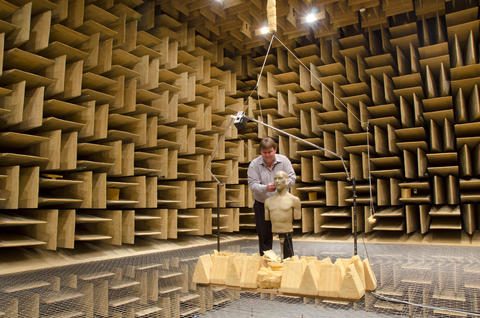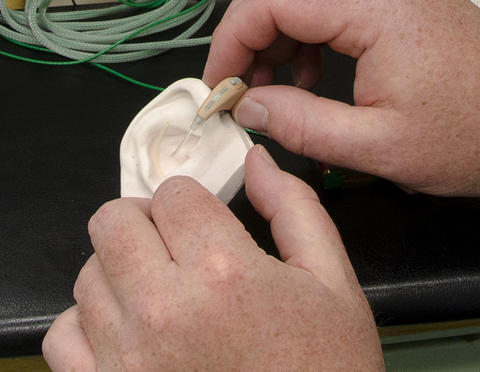
Randy Wagner prepares a standardized manikin for hearing aid testing in the team's largest anechoic chamber.
Randy Wagner and the rest of the Acoustics Team in PML's Semiconductor and Dimensional Metrology Division are planning new research directions as they celebrate the reinstatement of an agreement with the Department of Veterans Affairs (VA) to continue to perform measurements to characterize hearing aids for the VA and to work with manufacturers and other stakeholders on the development and standardization of these measurements. The Acoustics team provides world-class measurement services and develops measurements and documentary standards for the SI unit of sound pressure and related acoustical devices and measuring instruments to the U.S. community.
This collaborative effort between the VA and NIST began in the 1950s, and most recently the agreement between the two agencies was reworked after being temporarily offline. Past measurements done under this agreement have included insertion gain (i.e., the difference between the aided and unaided sound pressure levels in the ear), directivity index, saturation sound pressure level, equivalent input noise level, coherence, battery drain, and total harmonic distortion. Although the exact research directions of the new agreement are still under discussion, early indications are that heavy emphasis will be placed on the characterization of feedback suppression and adaptive directivity features.
These measurement efforts at NIST have the potential to impact the quality of life for a huge portion of society. According to the National Institutes of Health, 1 in 3 people between the ages of 65 and 74 and nearly half of those 75 and older have hearing loss.1 But, it's not just our older population that's affected. Veterans coming home from the wars in Iraq and Afghanistan have increased the need for new hearing aid measurements and standards for the VA, which happens to be the largest integrated healthcare system in the United States.
"The VA is serving a larger community now," explains Wagner, a physicist in the Acoustics Team. "The second most common disability of the soldiers coming home is defective hearing." Based on the increasing number of patients coupled with a greater complexity in hearing aid technology, Wagner contends that "Now more than ever, they require the work that NIST does."
NIST is uniquely positioned for these kinds of sound measurements with an exceptionally large and quiet 450 m3 anechoic chamber among its state-of-the-art facilities. When equipped for hearing aid directivity measurements, the room's centerpiece is a life-sized manikin torso on a rotating table, surrounded by a mechanical system for positioning a loudspeaker at different elevation angles.
"Most laboratories don't have chambers like this," Wagner states. "If you want to make controlled measurements, you don't want sound bouncing back off the walls. That's the purpose of this room. It absorbs practically all of the incident sound at the surfaces."
The minimum frequency range specified for the standardized directivity measurements made in this chamber is 500 Hz to 5 000 Hz. About 84 % of the signal needed to understand speech is contained in this range, according to the band importance function (weightings) used to calculate the Speech Intelligibility Index. Wagner stated "We've demonstrated the capability to make these measurements over the extended range from 200 Hz to 8 000 Hz," which covers about 99 % of that signal.

When it comes to the measurements NIST performs for the VA, "We prefer to have the manufacturers on board with our measurement procedures," Wagner states. "That's why it is so valuable to be in the working group. You want to share ideas and work on the consensus development of standardized procedures with the manufacturers and other stakeholders."
The need for feedback prevention in hearing aids has been exacerbated because of the proliferation of open-fit hearing aids (see figure below). "When the ear is plugged by a custom in-the-ear aid or a closed earmold, it causes an unnatural sensation known as the occlusion effect, which can be really annoying to hearing aid users," Wagner explains. "People usually find it much more comfortable to have their ears open as they wear their hearing aids and, aesthetically, more pleasing."
However, the open design of this popular type of hearing aid leads to serious problems with feedback. "The physical setup of the aid is working against you acoustically," Wagner explains, referring to the open path of this configuration between the output port of the amplified sound and the hearing aid microphone.
In a recent presentation at the Joint Defense Veterans Audiology Conference, the feedback suppression feature in hearing aids was given an "A" rating in both "Benefits" and "Wide applicability" and was the only feature out of seven reviewed to receive an A in either category.2
When it comes to the feedback suppression feature, Wagner states "The holy grail for the manufacturers is to get a significant amount of additional stable gain out of the aids before they feed back."
Another concern is how well this feature avoids generating entrainment artifacts, which can be produced if an aid attempts to suppress signals mistaken for feedback, such as alarms. Steps toward developing standardized test methods by Wagner and his team will include gain measurements done sequentially on aids with the feedback suppression features enabled and disabled, inducing feedback by incrementally increasing the gain, by changing the coupling to the ear, and also possibly by placing objects in close proximity of the aids to affect the feedback path. Other steps will include developing objective criteria for determining when feedback is occurring and to what extent, by analyzing the measured output spectrum and frequency response. In addition, communications with manufacturers about their specific approaches to suppressing feedback and performing laboratory measurements to characterize the performance of their features are planned.
Adaptive directivity put simply is where the aid looks for the desired signal, which is usually speech, and changes its directional pattern to focus on this signal. Newer hearing aids have adaptive features with directional microphones (usually two per aid) to follow speech. The testing at NIST will need to be enhanced to accommodate these features.
"The development of standardized measurement procedures to characterize adaptive directivity is one of the next big things," Wagner states.
In the case of new wireless technology, the aids on each ear of a binaural pair communicate with each other and work together to adapt their directivity based on the direction of the sound being detected.
"You've got the aids talking to each other on both sides of the head," Wagner explains. "If someone is speaking on one side of the wearer's head, the aids can detect this and have just the one side take over. If the speech is in the center, the aids are able to split the difference."
1"Dealing With Hearing Loss: Hearing Aids Can Help," NIH News in Health, December 2007.
2"Today's Hearing Aid Features: Fluff or true patient benefit?" by Todd Ricketts and Gus Mueller at the Joint Defense Veterans Audiology Conference (JDVAC) 2012.
Written and photographed by Erik Secula

